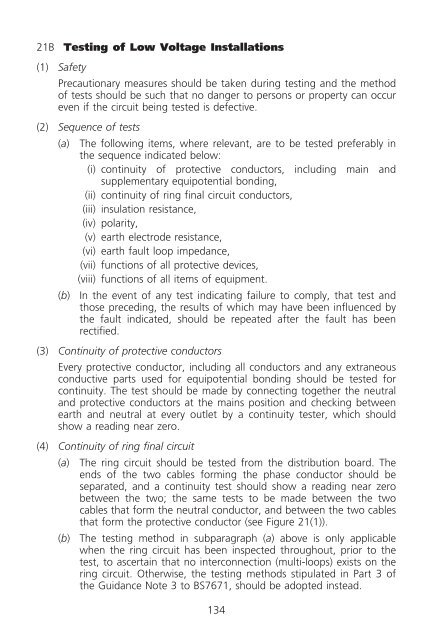Code of Practice for the Electricity (Wiring) Regulations - 2009 Edition
Code of Practice for the Electricity (Wiring) Regulations - 2009 Edition
Code of Practice for the Electricity (Wiring) Regulations - 2009 Edition
Create successful ePaper yourself
Turn your PDF publications into a flip-book with our unique Google optimized e-Paper software.
21B Testing <strong>of</strong> Low Voltage Installations<br />
(1) Safety<br />
Precautionary measures should be taken during testing and <strong>the</strong> method<br />
<strong>of</strong> tests should be such that no danger to persons or property can occur<br />
even if <strong>the</strong> circuit being tested is defective.<br />
(2) Sequence <strong>of</strong> tests<br />
(a) The following items, where relevant, are to be tested preferably in<br />
<strong>the</strong> sequence indicated below:<br />
(i) continuity <strong>of</strong> protective conductors, including main and<br />
supplementary equipotential bonding,<br />
(ii) continuity <strong>of</strong> ring final circuit conductors,<br />
(iii) insulation resistance,<br />
(iv) polarity,<br />
(v) earth electrode resistance,<br />
(vi) earth fault loop impedance,<br />
(vii) functions <strong>of</strong> all protective devices,<br />
(viii) functions <strong>of</strong> all items <strong>of</strong> equipment.<br />
(b) In <strong>the</strong> event <strong>of</strong> any test indicating failure to comply, that test and<br />
those preceding, <strong>the</strong> results <strong>of</strong> which may have been influenced by<br />
<strong>the</strong> fault indicated, should be repeated after <strong>the</strong> fault has been<br />
rectified.<br />
(3) Continuity <strong>of</strong> protective conductors<br />
Every protective conductor, including all conductors and any extraneous<br />
conductive parts used <strong>for</strong> equipotential bonding should be tested <strong>for</strong><br />
continuity. The test should be made by connecting toge<strong>the</strong>r <strong>the</strong> neutral<br />
and protective conductors at <strong>the</strong> mains position and checking between<br />
earth and neutral at every outlet by a continuity tester, which should<br />
show a reading near zero.<br />
(4) Continuity <strong>of</strong> ring final circuit<br />
(a) The ring circuit should be tested from <strong>the</strong> distribution board. The<br />
ends <strong>of</strong> <strong>the</strong> two cables <strong>for</strong>ming <strong>the</strong> phase conductor should be<br />
separated, and a continuity test should show a reading near zero<br />
between <strong>the</strong> two; <strong>the</strong> same tests to be made between <strong>the</strong> two<br />
cables that <strong>for</strong>m <strong>the</strong> neutral conductor, and between <strong>the</strong> two cables<br />
that <strong>for</strong>m <strong>the</strong> protective conductor (see Figure 21(1)).<br />
(b) The testing method in subparagraph (a) above is only applicable<br />
when <strong>the</strong> ring circuit has been inspected throughout, prior to <strong>the</strong><br />
test, to ascertain that no interconnection (multi-loops) exists on <strong>the</strong><br />
ring circuit. O<strong>the</strong>rwise, <strong>the</strong> testing methods stipulated in Part 3 <strong>of</strong><br />
<strong>the</strong> Guidance Note 3 to BS7671, should be adopted instead.<br />
134














